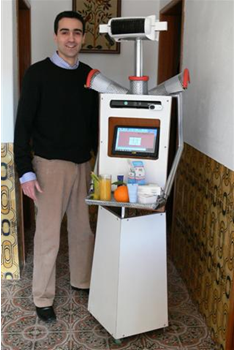Feb 27 2013
A University of Salford researcher has come up with a novel way of dealing with stretched resources caused by us all living longer – an interactive care robot for elderly people.
Antonio Espingardeiro has created the P37 S65 robot which has the ability to remind elderly people to take their medication and exercise, and can even tell jokes. It can also provide 24-hour emergency notifications and will directly connect to carers or GPs through video conference or SMS.
 P37 S65 robot which has the ability to remind elderly people to take their medication and exercise. Image courtesy of Salford University.
P37 S65 robot which has the ability to remind elderly people to take their medication and exercise. Image courtesy of Salford University.
As resources to care for the elderly become more strained, Antonio believes that his robot can supplement the intensive care required by many care home residents and conduct routine tasks without significantly reducing the human contact that people need. Crucially, one person can monitor many robots – requiring fewer trained staff at each site.
In fact, based on his earlier studies in care homes he believes that his robot can actually improve quality of life for the elderly by promoting exercise, playing games and acting as a video link to family and loved ones. It will also support carers by following them around with meals and alerting them to emergencies and regular appointments.
His robot can be programmed with many routine health interventions that are designed for people with dementia – such as speech therapy and object recognition exercises. Through face recognition it can also remember the preferences and requirements of each patient, as programmed at the instruction of a human worker.
Antonio conducted initial fieldwork with existing commercially available robots and discovered that residents found them to be highly stimulating and a break from their normal environment. He feels that, with his bespoke P37 S65, there is even more scope for the robot to support the work of human professionals in the exercise of care.
“Care of the elderly is a difficult issue, but as populations age, we’re facing a difficult choice,” he said. “Do we employ more people from a smaller workforce to care for us in our old age, or do we provide lower standards of care with fewer resources?”
“With my robot I believe that we can avoid this problem. I’ve already established that robots can provide meaningful interaction to supplement human contact, and from my work with care homes, I’ve seen first-hand how both staff and residents benefit from their presence.”
While Antonio now has a prototype he is looking for investment to conduct field trials and perfect the robot’s systems ahead of a full product launch.